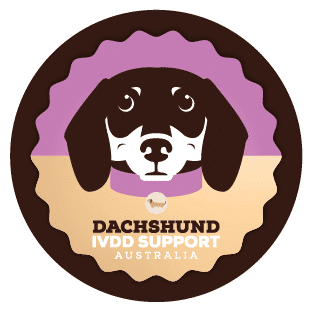Whether treating conservatively or surgically, rehabilitation has proven to be paramount in a dachshund’s recovery and future well-being following an IVDD event.
Surgical
We cannot emphasise enough the importance after surgery that you discuss with your vet specialist an immediate referral to a rehabilitation facility. The sooner the better normally recommended within a week after discharge as it is important that you are shown how to do the gentle exercises required to ensure you are doing the physio correctly so that muscle wastage is kept to a minimum during the crate rest period. Once you are shown this you can then assist your dog at home during the healing process without losing too much strength.
Please note that each specialist centre has different time frames that they keep your dachshund in the hospital. Some are discharged after 24hrs whereas some keep the dogs in for anything up to 2 weeks. It really also depends on how severely affected your dog was and whether their post-operative management can be managed at home sufficiently. Some vet practices also believe that your dachshund will heal and recover better in their own relaxed home environment. So it all varies for each individual dog but the most important thing is that an aftercare rehabilitation plan is put in place on discharge and a referral as necessary is made.
Some dachshunds after surgery do very well and some do get up albeit gingerly within the first 24hrs and others do take a little longer. If your dachshund is one of the lucky ones and your dog is walking the following day this does not mean you simply go home and resume a normal life. It is all about living the ‘new normal’.
There is a lot of healing to be done internally and it does take time and patience, even for the hound who is up and walking immediately following surgery, slowly does it, it’s not a race!
To access a timeline and rehab program for owners who are surgically rehabilitating an IVDD hound click on the link below.
Conservative
The “Holy Trinity” of conservative treatment (medical management) of IVDD is crate rest, correct well balanced pharmaceutical management, alternative modalities and having a proactive and knowledgable professional team having you and your hounds back!
This approach requires patience and time. It’s all about healing and pain management where nature is allowed to take its course and the affected area is encouraged to heal through extended rest and accompanied with gentle modalities such as acupuncture, laser and supplements. It requires strict crate rest and dedication by the owner and isn’t for the faint-hearted.
When treating your dog conservatively it is crucial to first discuss your dog’s rehabilitation plan with your vet/specialist or a qualified therapist. as each dog is different, and so is each herniation, You and your practitioner are responsible for your dog’s treatment. In the early stages of conservative treatment, passive modalities are recommended so as to avoid further damage while the affected discs are allowed to heal.
Please understand that conservative treatment of IVDD is quite straight forward commonsense stuff and not complicated at all; the most difficult aspect for human owners is finding patience.
Many different passive modalities can be employed when rehabilitating a dog undergoing conservative management of IVDD. Possible options might include – laser, therapy, gentle massage, acupuncture, range of motion exercises and stretches & muscle stimulation.
To access a timeline and rehab program for owners who are conservatively (medically managing) IVDD click on the link below.
